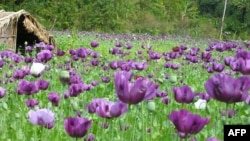The Asian Development Bank and other international donors have been helping Laos promote alternative development schemes to opium production. Analysts also point to opium’s traditional place in ethnic hill-tribe societies, including medicinal use, warning programs to eradicate the poppy must be backed by successful efforts to alleviate often chronic poverty
Laos, historically seen as a part of the Golden Triangle region of Myanmar and Thailand - the focus of the narcotics trade in South East Asia, has been been considered a success story in eradicating opium poppies.
Poppy cultivation in Laos fell from a peak of 26,800 hectares in 1998 to 1,800 hectares by 2005, due to an aggressive poppy clearing program. In 2006 the Laos government declared the country ‘drug free.’
In its 2014 opium survey the U.N. Office on Drugs and Crime (UNODC) said poppy cultivation in Laos had risen to some 6,200 hectares. But unlike Myanmar, where much of the opium is sent abroad or processed into heroin for export - much of the opium in Laos is consumed locally.
The UNODC said opium production, addiction and poverty are all linked to a lack of alternative livelihood options.
Cheikh Ousmane Toure, the UNODC’s Lao country manager said often villagers simply grow poppy to meet basic necessities rather than for the drug to be trafficked. “The opium growers are not bad people. They are people who are poor, who want to send their kids to school. They are not really doing trafficking. For a large number of them [opium] is used only for themselves,” he said.
In the highland provinces, ethnic communities of the Akha, Hmong and Khmu people are among the main growers of opium. They are also among the poorest provinces in Laos with more than 40 percent of inhabitants living below the poverty line, according to U.N. reports. Per capita incomes are as low $300 a year in contrast to just over $1,000 elsewhere in Laos.
But the rapid push to clear poppy fields has not been without consequences, often leaving families even more desperate and without alternative income sources.
In 2008 the World Food Program was forced to launch a two-year emergency assistance scheme to meet food shortages in three provinces. The UNODC said the economic plight of communities relying on opium for cash was often ‘precarious’.
But international development programs, backed by funds from Asian Development Bank (ADB), European Union (EU) and funding from Japan have all sought to bridge the development gap in promoting alternative development.
The UNODC’s Toure said increasing numbers of farmers have benefited from the projects. “In Oudomxai [province] today you will see work done by the government in cooperation with the UNODC and also Royal Thai projects introducing new techniques, new varieties of foods and how families who are former opium growers were able to increase their income,” he stated.
But some analysts question the value of crop eradication and alternative development programs, saying often local communities have insufficient input into the programs’ direction.
David Mansfield, an independent consultant, writing in the 2011 Global Commission on Drug Policies said crop eradication also pushes up the price of illicit drug crops, stimulating further production, and leading to “increasing levels of instability”.
American anthropologist, David Feingold, with 40 years experience studying opium in South East Asia, said many in the highland communities rely on opium in areas such as a traditional medicine. Feingold said a unit or ‘joy’ of opium, about 1.6 kilograms, once was easily transported and exchanged.
“It’s the best drug they have that in terms of medicinal uses. It’s save you if you have dysentery - or for coughs, colds and as a pain killer," he noted. "It has an important value as a currency. It was like American Express travellers - don’t leave home without it and you could cut off a particular weight and pay for things.”
Feingold said the success or failure of alternative development programs rests on crops reaching markets backed by sustained demand. Any failure will drive farmers back to poppy cultivation.
International aid agencies say to sustain the reduction in poppy requires poverty alleviation policies and a ‘holistic’ view to development covering areas such as education, health and infrastructure programs.







